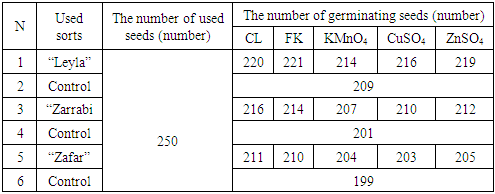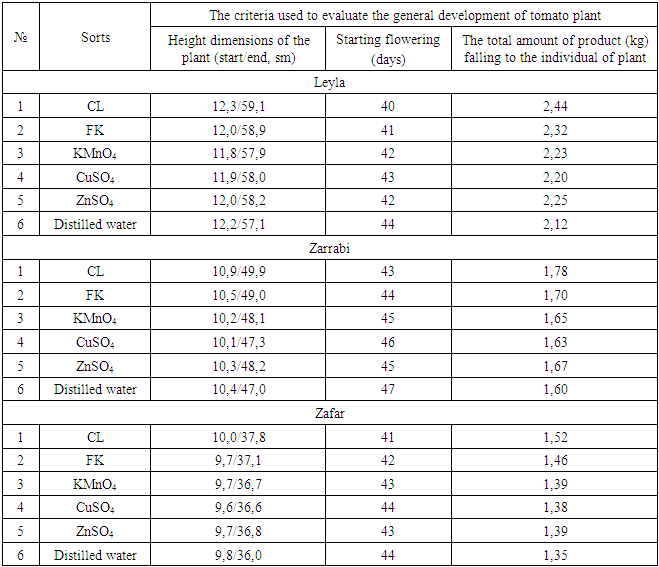-
Paper Information
- Paper Submission
-
Journal Information
- About This Journal
- Editorial Board
- Current Issue
- Archive
- Author Guidelines
- Contact Us
Advances in Life Sciences
p-ISSN: 2163-1387 e-ISSN: 2163-1395
2019; 9(1): 11-14
doi:10.5923/j.als.20190901.03

The Factors Affecting to the Productivity of Tomato Cultured in Azerbaijan and Ways of Its Elimination
Allahverdiyev E. İ.1, Shirinova G. F.2, Asgerli L. Gh.2
1Scientific-Research Institute of Vegetable of Ministry of Agriculture of the Republic of Azerbaijan
2Institute of Microbiology of the NAS of Azerbaijan, Baku
Correspondence to: Allahverdiyev E. İ., Scientific-Research Institute of Vegetable of Ministry of Agriculture of the Republic of Azerbaijan.
| Email: |  |
Copyright © 2019 The Author(s). Published by Scientific & Academic Publishing.
This work is licensed under the Creative Commons Attribution International License (CC BY).
http://creativecommons.org/licenses/by/4.0/

The purpose of the presented work was dedicated to the study of factors that affect the productivity of tomato plants, and its elimination. It has become clear that there are opportunities available to raise the germination of seeds obtained from different types of tomatoes and for this purpose is convenient to use both chemicals and substances obtained from some fungi. Thus, due to the effects of all the materials used for the processing of seed increases both the germinate ability of the seeds, and the overall productivity of the plant. The quantitative indicator of these processes is expressed by 6,9% in the increase of germinating ability of seed and 15,0% in the increase of overall productivity. As a result of the research, was shown that the culture liquid of the fungus Trichoderma koningii more effective.
Keywords: Tomatoes, Seeds, Germination, Total tomato productivity, Biochemical composition
Cite this paper: Allahverdiyev E. İ., Shirinova G. F., Asgerli L. Gh., The Factors Affecting to the Productivity of Tomato Cultured in Azerbaijan and Ways of Its Elimination, Advances in Life Sciences, Vol. 9 No. 1, 2019, pp. 11-14. doi: 10.5923/j.als.20190901.03.
1. Introduction
- As is known, for the efficient nutrition of people during the year they must equally take plant origin products first of all melons and vegetable crops. For this reason, the provision of the population of the world with the mentioned plant products is one of the most important tasks [1-2] and one of the most important areas of the economic policy in any country. As part of the world, this issue is always in the focus of attention in the Republic of Azerbaijan. The natural soil-climatic conditions of the Republic of Azerbaijan where the agrarian sector takes an important part in the economy is different, as well as suitable for the cultivation of vegetable crops [3]. Despite this, today the satisfy the need of the country's population for such products is impossible to fully secured at the expense of local production and some types of these products are imported to the country [4]. This fact alone makes possible to say with certainty the development of vegetable crops in the country in order to fully secure the need of the country is one of the important tasks of the day. In terms of the resolution of this issue increase productivity of vegetable varieties grown in the country, determining and elimination the circumstances leading to a decline in their productivity, purchase of new productive varieties, etc. is one of the important problems that await its solutions.It should be noted that vegetable crops are cultivated all over Azerbaijan, and many of them are cultivated both in open and covered conditions. One of these vegetable plants is a tomato that holds one of the leading places both by the sowing area and production volumes among vegetable crops cultivated in both conditions. For example, in 2017, in the Absheron region of the Republic of Azerbaijan, the 468 ha area were cultivated with tomatoes, 33 ha eggplants, and on the 178 ha with other vegetable crops [3]. The produced product is intended to meet the need of the population of large cities, as well as industrial centers and export to foreign countries. More precisely, tomato is one of the products exported today which is important in terms of increasing the country's export potential. On the other hand, the tomato is important as food, because it includes valuable compounds that are necessary for normal human activity (vitamins, organic acids, mineral salts, sugars, etc.) that are essential for the normal life of a person. Thus, tomato contains 4-5% sugar, A, B, C vitamins, B and B2 provitamins, apple and lemon acids, protein compounds, iron, mineral salts, and other compounds [5-6]. Tomatoes have both export and high nutritional quality. Therefore, to determine of cases that lead to a decrease of productivity during cultivation [7-8], and to carry of research for its eliminating [9] is one of the matters that always differs by its relevance. This issue is of particular importance with a constant increase in the world's population within a stable territory of the globe.Taking this into account, the objective of the presented work was dedicated to identifying the factors affecting the productivity of tomatoes grown in Azerbaijan and the ways to remove them.
2. Material and Methods
- The research was carried out in the practice areas of Absheron Support Experience Farm of Scientific-Research Institute of Vegetable For this purpose were use varieties like as "Leyla" for the universal purpose, "Zarrabi" for the cover the table, and "Zafar" for tinned (4500 km) that are carry for a long distances. During the study of the germination ability of the seeds the 100 are visually healthy seeds of the plant seeded with tested solutions at room temperature for 24 hours. These seeds are then placed on the surface of the filter paper soaked in the water used for irrigation and seed germination controlled for 5 days. As control were used seeds soaked with water which are using for irrigation. 1. For the obtain the culture liquid(CL) of the fungus Trichoderma koningii, a pure culture of the fungi was grown in Czapek liquid medium and cultured for 7 days. After filtration, the resulting supernatant was used as CL. Growing of fungi, isolation of biomass, etc. were carried out according to known methods [10].2. Fuzikokin (FK) solution was also prepared in distilled water and the density of the prepared solution was about 0.043%. 3. The density of mineral elements in different solutions was KMnO4 1%, CuSO4 - 0.02% and ZnSO4 - 0.002%. The solutions were prepared in distilled water.During the cultivation of selected varieties for research in the field condition, the seeds were sown in the following times for germination: 5-10.III, 15-20.III, 25-30.III, 5-10.IV, 15-20.IV, 25-30.IV. The irrigation, thin out, softening the bottom of the plants, feeding, etc. agrotechnical services needed for the varieties of tomato plant cultivated both for practice and for control purposes were carried out on the based of widely used approaches currently [11-12]. During the phenological observations were registered the first (25% of sown seeds) and mass (75% of sown seeds) obtained germination, the appearance of the first true leaf, formation of 4-5 leaf phases. Biometric measurements on plants were performed in each phase - the leaves counted, the main body measured.The formed seedlings have been planted in a constant place by 70 x 40 cm scheme (With 10 days pause from 01.04 to 30.05 of each year). From each variety are planted 30 plant species and the crops were at least 4 repeats. In the planted areas were carried relevant agro-technical measures, phenological observations, and noted massive technical adulthood, first and last harvest dates. In the end, after the fruits the fully formed (technical ripeness), the fruits on the shrub are counted, drawn, determined the average weight (q) of fruit or product falling to the one shrub. The total amount of dry matter (%), acid (%), total sugar (%) and vitamin C (mg) containing in the ripe fruits received from each period were determined by the known methods [13]. The cultivation was done in two forms: the first of which was based on the well-known approach [9] to the cultivation of tomatoes currently, and the second is the approach that formed based on the results obtained from our research. All experiments performed at least 4 repeats and the results were statistically evaluated [14].
3. Results and Their Discussion
- One of the main conditions for obtaining high yields from agricultural crops is the correct selection of the sort that meets the requirements of the production [15]. Therefore, in the course of our research, we were used varieties like as "Leyla", "Zarrabi" and "Zafar" obtained in the Scientific-Research Institute of Vegetables of Ministry of Agriculture of the Republic of Azerbaijan and characterized by favorable indicators. Thus, in the course of the research were identified perspectivity of these varieties and selected for the wide cultivation. For the demonstrates potential productivity of any variety selected for wide cultivation is required certain conditions. In its formation to attain particular importance natural climatic conditions of the area, high seeding ability of selected seeds, more products in the process of vegetation, characterization of the biochemical indicators of the product with the required quantity indicators received in the result of increased productivity. Given the importance of this in the course of the research, firstly was clarified issues related to the germination of seeds of the studied varieties of the tomato plant. For this purpose have been used materials obtained from different sources. From the obtained result became that all of the used materials this or that extent have a positive effect on the germination of the seeds of the plant varieties, but they slightly differ from each other by its quantitative indication (tab. 1). For example, during the use of CL and FK the germination ability of seeds of Leyla, Zarrabi, and “Zafar” varieties rise compared to the control. Analogy situation observed during using from the products of inorganic substances but the effect of growth is in a sense differ from each other. Despite this difference, it is impossible to say which of the used materials is more favorable.
|
|
4. Conclusions
- As a result of the conducted research was shown that one of the factors affecting the productivity of tomato is the primary seed treatment. All of the various substances used for processing increase the germination of plant seeds, increases overall productivity. But in this case, the use of CL obtained from the fungi Trichoderma koningii is more profitable which leads to an increase in overall productivity. In addition, the resulting product also meets the requirements for quality indicators.
 Abstract
Abstract Reference
Reference Full-Text PDF
Full-Text PDF Full-text HTML
Full-text HTML
